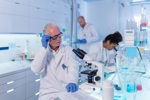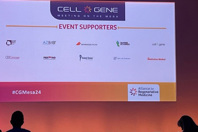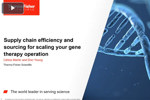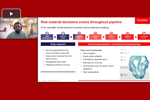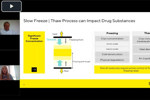Cell & Gene Therapy Cold Chain: Ensuring Product Integrity
Cell and gene therapies are extremely sensitive to temperature changes and require rigorous temperature control throughout the supply chain, from packaging and shipping to storing and retrieving for patient use.
Sophisticated cold chain management solutions protect these therapeutics from harmful external factors and contamination, ensuring quality and safety while meeting regulatory requirements. Cold chain solutions can also extend the product's shelf life and reduce waste.
As the cell and gene therapy market grows, so does the demand for advanced cold chain logistics, including robust solutions that can manage global distribution. This comprehensive guide covers the fundamentals of cell and gene therapy cold chain logistics, including:
- Understanding The Cell And Gene Therapy Cold Chain
- Key Cold Chain Components For Cell And Gene Therapies
- Technical Challenges In Cold Chain Logistics
- Innovations In Cold Chain Logistics For Cell And Gene Therapy
- Market Trends And The Future Of Cold Chain Logistics
- Case Studies And Applications
- Frequently Asked Questions (FAQs)
Understanding The Cell And Gene Therapy Cold Chain
Cold chain logistics manages biopharmaceutical products’ transportation, storage, and handling while maintaining specific temperature ranges at ultra-low or cryogenic levels to preserve their integrity, potency, and quality. Additionally, advanced monitoring and tracking technologies create detailed chains of identity (COIs) and custody (COCs) to protect product safety.
What Is Cold Chain Logistics?
Cell and gene therapies are incredibly fragile and require special handling during collection, transport, and administration, such as:
- Temperature-controlled packaging and shipping containers
- Specialized refrigerated vehicles and storage facilities
- Advanced monitoring and control systems for real-time visibility
- Rigorous SOPs
In addition to temperature control, cold chain logistics also manage products’ short viability windows, the complexities of global distribution, and stringent regulatory requirements. Advanced solutions are extending product shelf life to reduce the need for "just-in-time" manufacturing approaches, and emerging technologies like the internet of things (IoT), AI, and blockchain methods are overcoming common supply chain challenges to increase scalability and accessibility.
Key Temperature Ranges And Their Importance
Biopharmaceutical products must be stored within precise temperature ranges, which vary according to the product type and formulation, such as:
Cryogenic Temperatures (-150°C and below)
Certain cell and gene therapies require cryogenic temperatures during transport and long-term storage to prevent degradation and maintain viability. Cell therapies are stored below -130°C to maintain cell structure integrity, while gene-modified cell therapies like CAR T-cell and TCR often require temperatures lower than -150°C.
Ultra-Low Temperatures (-70°C to -80°C)
Ultra-low temperatures prevent RNA degradation and maintain biological stability. Monoclonal antibodies and mRNA vaccines are stored between -20°C and -80°C. Gene therapies, especially those using vectors like adeno-associated viruses, are usually stored around -80°C.
Refrigerated And Controlled Room Temperature (2°C to 25°C)
Although cryogenic and ultra-low temperature requirements are common, some components and products can be safely kept at higher temperatures, particularly for short-term storage or during handling or preparation.
Refrigerated temperatures (2°C to 8°C) suit products that must be kept cool but not frozen, and controlled room temperature (20°C to 25°C) is appropriate for products that don't require freezing or refrigeration.
Key Cold Chain Components For Cell And Gene Therapies
Cold chain logistics are designed to meet the specific needs of the cell or gene therapy and include storage temperature requirements, packaging solutions, and transportation strategies. Specialized equipment, a dedicated infrastructure, and operational procedures provide consistent temperature control during storage, transportation, and handling.
Cryopreservation Techniques For Long-Term Storage
Cryopreservation maintains extremely low temperatures that preserve sensitive biological products’ viability and functionality for an extended time.
Controlled-Rate Freezing
Specialized equipment controls the cooling rate to prevent rapid cellular dehydration and ice crystal formation. Controlled-rate freezers or isopropanol-containing containers cool the therapeutics at -1°C/minute, which is appropriate for most cell types.
Vitrification
Vitrification offers an alternative to slow freezing. Products are rapidly cooled into a glass-like state that avoids ice crystal formation using higher concentrations of cryoprotectants than slow freezing.
Storage Conditions
After freezing, cryopreservation maintains extremely low temperatures, typically employing liquid nitrogen tanks that maintain temperatures of -135°C to -196°C. Storing products below -130°C halts metabolic changes and maintains product integrity.
Cryoprotectants
Cryoprotective agents (CPAs) protect biological products from freezing and thawing damage. CPAs reduce ice crystal formation, lower cells’ freezing points to prevent intracellular ice formation, regulate osmotic stress, and preserve intracellular organelles. Additionally, CPAs can promote vitrification by allowing the solution to maintain flexibility in a glassy phase without crystallization. Commonly used CPAs include:
- Dimethyl sulfoxide, often used at 5-10% concentration
- Plasma, serum, or human serum albumin
Thawing And Recovery
Cell and gene therapies can be damaged during the thawing process if not properly managed. Rapid thawing methods are generally recommended to minimize ice crystal formation, while post-thaw processing removes cryoprotectants.
Packaging And Temperature Control Solutions
Dedicated packaging and temperature control solutions protect cell and gene therapies from degradation.
Thermal Packaging Technologies
Thermal packaging maintains specific temperature ranges for cell and gene therapy products during transportation, often via phase-change materials that maintain temperatures from -4°C to over -150°C, depending on the product's needs.
Cryogenic Shippers And Dewars
Cryogenic shippers and dry nitrogen vapor shippers (dewars) maintain cryogenic temperatures (-150°C and below) for up to 14 days, enabling global distribution.
Storage Solutions For Cell And Gene Therapies
Cell and gene therapies require specialized storage equipment, chosen according to the product’s requirements, stability, and intended shelf life. Common solutions include:
Cryogenic Storage Systems
Liquid nitrogen tanks and dewars store products at -135°C to -196°C. Dry shippers use absorbed liquid nitrogen to preserve cryogenic temperatures without spills.
Ultra-Low-Temperature Freezers
Ultra-low-temperature freezers maintain -80°C for shorter-term storage or products stable at slightly higher than cryogenic temperatures.
Refrigerators
Standard medical-grade refrigerators store products at 2°C to 8°C, typically for short-term preservation or immediate use.
Controlled Room Temperature Storage
Temperature-controlled rooms or cabinets are kept at 15°C to 25°C for products designed to withstand room temperatures.
Monitoring And Control Systems
Temperature mapping systems ensure consistent temperature distribution within storage units, while continuous monitoring systems provide real-time temperature data and alerts for deviations. FDA Title 21 CFR Part 11 compliant systems offer temperature and humidity monitoring in regulated environments.
Transportation Logistics
Transportation and monitoring logistics ensure cell and gene therapies reach patients in optimal condition while complying with regulatory standards.
Specialized Vehicles And Air Freight Systems
Specialized vehicles and air freight systems maintain ultra-low temperatures during transport to protect sensitive biologics. Dry shippers are the preferred method for air transport, while climate-controlled vehicles are used in ground transportation. Advanced packaging solutions can maintain temperatures from -4°C to -150°C without dry ice, extending shipping durations.
Real-Time Shipment Monitoring
Shipments must be continuously monitored to protect cell and gene therapies’ integrity. Advanced systems provide real-time data on environmental conditions such as temperature, humidity, and shock and often integrate GPS for continuous visibility throughout shipping and delivery. Real-time monitoring supports QA and regulatory compliance while enabling proactive intervention if deviations occur, minimizing product loss.
Technical Challenges And Best Practices In Cold Chain Logistics
Cold chain logistics are highly technical and vulnerable to supply chain disruptions. Companies should mitigate these risks through proactive measures, advanced technologies, QA strategies, and staff expertise.
Maintaining Cold Chain Integrity
Cold chain integrity ensures cell and gene therapies remain undamaged and fully potent on their complex journey from manufacturing sites to patients. Therefore, rigorous documentation regarding temperature excursions, COI, and COC validates the drug product's safety and efficacy.
Temperature Excursions And Risks To Therapy Viability
A temperature excursion occurs when a biopharmaceutical product is exposed to temperatures outside its safety range, which can diminish its quality, quantity, and viability. Even short excursions can damage or destroy cell and gene therapies.
Specialized packaging and transportation methods and real-time temperature monitoring systems mitigate these risks. Additionally, proper handling procedures and staff training minimize excursions. For example, uncontrolled warming can lead to inconsistencies between cryobags or batches, highlighting the need for intensive handling procedures.
Chains Of Identity And Custody
COI and COC provide critical product traceability. COI uses unique identifiers to track a cell or gene therapy from initial tissue procurement to final product and patient administration.
COC records points of transfer and control, including starting materials and in-process manipulations. These systems are crucial for autologous therapies because delivering the wrong product to a patient could cause serious harm or death. However, a lack of standardized definitions and strategies for COI and COC can create tracking system incompatibility and errors.
Currently, the industry is addressing these challenges by developing standardized COI identifiers, implementing robust tracking systems and verification steps at each stage of the process, and stressing the need for clear communication and collaboration among supply chain stakeholders.
Mitigating Weather, Shipping, And Geopolitical Challenges
Many factors outside the industry's control, including weather emergencies, shipping challenges, and geopolitical unrest, can negatively affect cold chain logistics. Companies should have contingency plans in place to avoid product loss.
Weather Emergencies
Weather emergencies upset shipping timelines, but these strategies mitigate their effects:
- Advanced monitoring systems provide near real-time data on environmental conditions, enabling companies to make proactive interventions.
- Specialized packaging solutions maintain ultra-cold temperatures for an extended time.
- Contingency plans and alternative routes help shippers detour around severe weather events.
Air Travel Challenges
Products shipped by air are subject to local or international regulations and are susceptible to potential delays. However, real-time tracking systems monitor shipments throughout their journey so companies can quickly respond to flight delays or cancellations. Additionally, partnerships with logistics providers and airlines help prioritize cell and gene therapy shipments so they make it onto flights as expected. Companies can also use dedicated charter flights for critical shipments, avoiding commercial air travel disruptions.
Geopolitical Unrest
International shipments of raw materials or therapeutics are vulnerable to political unrest or complex regulations. Companies can better manage international shipments by working with logistics providers who are experts in navigating complex international regulations and customs procedures. Another strategy is diversifying the supply chain by establishing multiple regional manufacturing and distribution centers. Finally, collaboration between biopharmaceutical developers, logistics providers, and regulatory bodies streamlines cross-border transportation.
Handling Variability In Therapy Types
Cell and gene therapies encompass a variety of treatments, each with specific cold chain needs and requirements. Companies must take a multi-pronged approach to managing the variability inherent in these therapeutics.
- Customized packaging solutions can be tailored to the specific temperature requirements of different therapies. For instance, advanced thermal packaging technologies can maintain temperatures from -4°C to -150°C for extended periods.
- Flexible temperature control systems maintain multiple temperature ranges, while cryogenic shippers and ultra-low-temperature freezers accommodate therapies requiring different storage conditions.
- Advanced monitoring and tracking systems provide data on environmental conditions throughout the supply chain while creating COIs and COCs for personalized therapies.
- Scalable infrastructure strategies adapt to varying volumes as the market grows, such as partnering with logistics providers to leverage temperature-controlled transportation options.
- Staff training and expertise through dedicated training programs ensure that staff can handle various therapy types and their unique requirements. Companies should nurture thermodynamics, materials sciences, and cold chain logistics expertise to address diverse therapy needs.
- Risk mitigation strategies for different therapy types address potential disruptions in the supply chain, and QA processes should focus on each therapy type’s specific risk factors.
Regulatory Compliance And Quality Assurance
Cell and gene therapies must meet stringent regulatory requirements and QA standards, including cold chain logistics. For instance, the FDA and EMA provide detailed guidelines for safely shipping and storing these therapies.
FDA Requirements
The FDA requires companies to follow good distribution practice guidelines, which extend QA throughout the logistics workflow. Drug packages must also comply with the FDA's serialization "track and trace" requirements, creating a detailed COC for each product.
EMA Requirements
The EMA outlines specific good manufacturing process guidelines for advanced therapy medicinal products, and companies must also comply with Directive 2001/83/EC.
Quality Assurance Strategies
Advanced QA strategies protect cell and gene therapies throughout the supply chain to ensure they remain safe and viable. For example, real-time monitoring systems continuously track environmental conditions. Specialized packaging solutions and tracking systems that maintain COI and COC are also part of a comprehensive QA strategy.
Companies should create contingency plans for potential supply chain disruptions and establish partnerships with logistics providers to access temperature-controlled transportation options. Dedicated staff training and regular risk assessments help companies create mitigation strategies and anticipate logistical hurdles.
Staff Training And Operational Excellence
Personnel who handle cell and gene therapies must be thoroughly trained in safe handling procedures. Additionally, companies should develop expertise in thermodynamics, materials sciences, and cold chain logistics to address diverse therapy needs.
Employing automation in storage and handling processes minimizes human error and improves efficiency. Standardized workflows and robust data management systems also reduce errors. Companies should practice continuous improvement through periodic training, retraining, and performance tracking.
Innovations In Cold Chain Logistics For Cell And Gene Therapy
Cold chain logistics is a costly and complex enterprise with high-stakes consequences; thus, companies are turning to advanced and emerging technologies to avoid product loss.
Emerging Monitoring And Tracking Technologies
Emerging monitoring and tracking technologies address longstanding inefficiencies in cold chain logistics, ensuring that cell and gene therapies remain safe and effective when they reach patients.
IoT, AI, And Machine Learning For Predictive Logistics
IoT, AI, and machine learning (ML) enable faster decision-making and create responsive supply chains that predict and prevent bottlenecks. Advanced IoT sensors provide real-time environmental condition data throughout the supply chain, while AI and ML leverage this data to predict potential issues and optimize logistics.
Blockchain For Traceability And Accountability
Blockchain technology offers an immutable, end-to-end traceability system for cold chain logistics. Materials and products are continually tracked through unique identifiers, while sensitive information like patient data is kept secure.
Automation In Cold Chain Logistics
Warehouse automation, assisted by AI and robotics, handles sorting, packing, and inventory management. These systems reduce latency, improve cost efficiency, and enhance issue identification.
Market Trends And The Future Of Cold Chain Logistics
Market trends towards personalized medicine, decentralized manufacturing and storage, and sustainable solutions are shaping the future of cold chain logistics.
Increasing Demand For Personalized Medicine
The growing field of personalized medicine targets heretofore “untreatable” diseases and conditions, but these therapies add complexity to cold chain logistics.
First, personalized medicine requires strict temperature control with no acceptable margin of error because patients only have one chance for treatment. Shipments are individually tracked and require costly specialized packaging and enhanced temperature monitoring. As these treatments grow in popularity, new and emerging technologies are crucial to meeting these challenges.
Decentralized Manufacturing And Localized Storage
Decentralized manufacturing and storage are reshaping cold chain logistics. First, decentralized manufacturing brings production closer to patients, which reduces long-distance transportation risks. This approach also scales out production to meet growing demands while reducing manufacturing failure rates. (However, there are tradeoffs to consider with distributed manufacturing.) Last-mile delivery solutions are another growing trend, with companies investing in advanced refrigerated delivery vehicles and innovative packaging.
Sustainability In Cold Chain Logistics
Sustainability in cold chain logistics emphasizes reducing energy consumption and packaging waste. Energy-efficient refrigeration systems and alternative transportation fuels lessen fossil fuel consumption, while recyclable and reusable packaging solutions reduce waste and meet consumer demand for environmentally friendly supply chain operations.
Case Studies And Applications
Real-world successes and lessons learned from failures highlight the critical importance of cold chain logistics.
Real-World Successes In Cold Chain Logistics
Innovations in cold chain logistics are improving cost-effectiveness and reducing risks:
- Advanced thermal packaging technologies maintain temperatures from -4°C to -150°C for extended periods, enabling global distribution.
- IoT sensors continuously track environmental conditions, enabling proactive interventions if issues arise during transport.
- Specialized cryogenic shippers and ultra-low temperature freezers protect cell therapy viability below -130°C.
- Dedicated clinical supply coordinators and capacity-building programs for investigational sites ensure seamless execution of complex cell therapy trials.
Lessons Learned From Cold Chain Failures
Cold chain failures can lead to costly product loss or even endanger patients. For example, during a clinical trial, a CDMO employee forgot to plug a freezer back in after cleaning, and the IP stored in that freezer was destroyed. Sadly, a patient died due to disease progression while waiting for the next round of treatment to be manufactured. The trial's enrollment dropped significantly, and the company's reputation was damaged, delaying its commercial launch plans.
This example demonstrates the importance of robust SOPs and multiple checkpoints for critical processes like freezer maintenance and product handling. Companies should also have contingency plans, such as collecting extra cells during apheresis and automating processes to reduce human error.
In another cautionary tale, a small fracture in a product bag that almost went unnoticed illustrates the need for precise handling and inspection procedures. Investing in staff training and operational excellence reduces these risks.
Conclusion
A comprehensive cold chain logistics strategy encompasses preservation techniques, advanced packaging and storage solutions, specialized transportation, continuous temperature monitoring, and detailed COIs and COOs. This process is complex, costly, and risky, but advanced technologies are improving cost-effectiveness and safety. Additionally, sustainable solutions are gaining popularity as companies seek ways to improve their environmental footprint while reducing costs. Given the high stakes associated with cold chain logistics, further research and development in cell and gene product stability and supply chain solutions are greatly needed.
For information on other aspects of the CGT production process, visit our pages on cell therapy manufacturing, gene therapy manufacturing, and fill-finish.
Frequently Asked Questions (FAQs)
Below are frequently asked questions regarding cold chain logistics for cell and gene therapies:
1. What temperature range is required for storing cell and gene therapies?
Cell and gene therapies typically require storage at cryogenic temperatures, ranging from -60°C to -150°C or lower. Some therapies may need to be stored in liquid nitrogen at as low as -196°C.
2. Why is temperature control so critical for cell and gene therapies?
Even brief exposure to incorrect temperatures can compromise these treatments' potency, safety, and viability. This can lead to significant financial losses and potential harm to patients.
3. What types of containers are used for transporting cell and gene therapies?
Common containers include dry ice shippers and dry nitrogen vapor shippers (dewars). These specialized containers can maintain the ultra-low temperatures required for preserving the therapies.
4. How long can cell and gene therapies be transported using cold chain solutions?
Advanced cold chain solutions can maintain appropriate temperatures for up to 3 weeks, allowing for extended product stability during transportation.
5. What monitoring systems are used for cell and gene therapies in cold chain logistics?
Real-time monitoring systems using IoT sensors track environmental conditions throughout the supply chain. These systems provide instant visibility into shipment conditions and allow for proactive interventions if issues arise.
6. What are some challenges in cold chain logistics for cell and gene therapies?
Key challenges include maintaining end-to-end temperature control, ensuring the chain of identity and custody, managing time and therapy longevity constraints, and complying with regulations and standards.
7. How is sustainability addressed in cold chain logistics for cell and gene therapies?
There's a growing emphasis on integrating sustainable practices, such as using energy-efficient refrigeration systems, alternative fuels for transportation, and eco-friendly packaging materials.
8. How is decentralized manufacturing affecting cold chain logistics for cell and gene therapies?
Decentralized manufacturing brings production closer to patients, reducing transportation distances and cold chain risks. This approach allows for scaling up production to meet growing demand and potentially lowers rates of out-of-specification products and manufacturing failures.
About The Author
Elizabeth Mann is a skilled writer with over a decade of experience in content creation, specializing in the life sciences industry. As a writer for Life Science Connect, she develops in-depth content that informs and engages professionals in the pharmaceutical, biotech, and medical device sectors. Her areas of focus include biologic drug production (including cell and gene therapies), clinical trial design and execution, and drug development and manufacturing outsourcing.
EXPERT INSIGHTS ON GCT COLD CHAIN LOGISTICS
-
CGT Industrialization Starts With CDMO Alignment
Fragmented processes are stalling progress. By aligning CDMOs through transparency and standards, developers can move past the COGS obsession and stabilize the supply chain.
-
Why Your MVP And Its Evolution Matters To Manufacturing
Minimum viable product is one of the most important inputs to developing a manufacturing process. It defines essentials that matter to the people who make the product.
-
Strained Manufacturing, Complexity Stymie In Vivo Progress
Explicitly mapping delivery challenges to the associated GMP process steps converts biological risk into operational risk.
-
Formulation And Delivery Considerations For Cell And Gene Therapies
How can we ensure cell and gene therapies are truly transformative for patients? Success depends on the right combination of formulation, preparation, and delivery.
-
Sensitive Critical Starting Materials Need A 'Just-In-Data' Approach
Here's a blueprint for transforming the fragmented, high-risk interface between vector and cell therapy platforms into a unified, predictable, and compliant system.
EDITORIAL PERSPECTIVES ON CGT COLD CHAIN LOGISTICS
-
Arcellx's CMO and CTO talk about the company's platform technology, its partnership with Kite, and preparing its lead asset, anito-cel, for commercial launch.
-
Allogene Therapeutics CEO and co-founder, David Chang, MD, Ph.D., talks about the exciting future of allogeneic CAR-T and shares the company's mission to bring these therapies to patients.
-
ARM's 2024 Meeting on the Mesa has concluded. Here are a few brief highlights from this year's conference.
-
The immune system makes therapeutic delivery challenging, even for immunotherapies. Learn how Calidi Biotherapeutics is using stem cells to sneak oncolytic viruses past the immune system to the sites of solid tumors.
-
Lee Clough RN, HP, of Novartis talks about the importance of understanding the nuances associated with collecting and shipping autologous material (i.e., CAR-Ts) for clinical trials.
ON-DEMAND COLD CHAIN WEBINARS
-
Manufacturing Made More Robust And Customer-Centric
Discover how regional manufacturing, risk-aware practices, and agile strategies are reshaping supply chains to deliver resilience, transparency, and sustainability in today’s complex global environment.
-
Supply Chain Efficiency And Sourcing In Gene Therapy
An overview of the inbound supply chain in gene therapy and the process development challenges that are frequently faced. Learn about concepts such as scaling, cell culture media sourcing, mixing technologies, and configurable packaging.
-
Supply Resiliency For Bioprocessing Amid Global Volatility
Build bioprocessing resiliency with strategic supply chain management. Learn to meet quality, compliance, and time-to-market demands amid global volatility with effective sourcing.
-
Solving Fragmentation: Future-Proofing The Advanced Therapy Supply Chain
Whether you are preparing for your first clinical shipment or scaling for global distribution, this conversation provides strategies to streamline operations, improve reliability, and deliver better patient outcomes.
-
Secure Your Sensitive Drug Substances
Explore the risks of freeze and thaw cycles on biological products and how an advanced plate freezing platform protects sensitive molecules with precision and ease.



